 |
| Photo credit - annayas.com |
Saul Bass? Don't I mean Phileas Fogg, the character who wagered he could circumnavigate the globe in 80 days? We'll get to him in a minute. First, let's focus on Saul Bass. Unless you've studied graphic design or are a film buff, you may have never heard of him; I had not until I came across this feature on the Noupe website. He was a graphic designer active between 1954 and 1995 whose "minimalistic, conceptual sequences helped film titles become an integral part of the story and ultimately the whole cinematic experience." You can watch videos of the work he did for such films as The Man with the Golden Arm, Vertigo, North by Northwest, West Side Story and more. The one that caught my eye was for Around the World in 80 Days.
I found it so clever and amusing – sort of 50s graphics meets Monty Python animation – that I decided to check out the movie. It premiered in 1956 and won the Academy Award for Best Picture of that year, beating out Friendly Persuasion, Giant, The King and I and The Ten Commandments, so my expectations were rather high. (It also won Best Cinematography, Best Music and Best Screenplay among others.) In addition to starring David Niven as the aforementioned Phileas Fogg, the Mexican comedian Cantiflas as his sidekick Passepartout, and a very young Shirley MacLaine, the film boasts appearances by a host of other big-time stars of the era, for which Mike Todd, the film's producer, invented the term "cameo," enticing these actors to sign on for a small jewel of a performance.
Now, there are some old movies, such as The Philadelphia Story with Katherine Hepburn, Cary Grant and James Stewart, or any of the The Thin Man series with Myrna Loy and William Powell, which I find as captivating to watch (and re-watch) as audiences did when they were first made, the film equivalent of classic, time-tested novels. But – wow! – was Around the World a different story. Like the Jules Verne novel which sired it, it's set in Victorian times, but to me it says reams about the culture of the era in which it was made. The film was shot in 112 locations in thirteen countries, and there's a lot of footage where we, the viewers, are simply watching the scenery go by, obviously a draw in an age when international travel still wasn't all that common. Other sequences such as a prolonged bullfight scene in Spain and an attack by Indians on a train in the American West reflect Mike Todd's assertion: "Bite your tongue when you call it a film. It's a show." From the library I borrowed a two-disc set with an introduction by Turner Classic Movies host Robert Osborne plus lots of special features which actually were perhaps more interesting than the movie itself. I was especially intrigued by the bio on Michael Todd, a man who truely lived large, whose only feature film Around the World was. And who you may remember was the third husband of Elizabeth Taylor, at the height of her beauty here in this bio, reminiscing about the man she called one of her three great loves (along with Richard Burton and jewelry.) So, would I recommend this movie? Hmm... Film critic Leonard Maltin concluded that this "Oscar-winning favorite has lost much of its charm over the years." But here's another well-considered and informative perspective on the film by British cinema critic and historian Tony Sloman that might make you want to watch it.
Now, let's return to what brought me to this movie in the first place: Saul Bass. If you don't have three hours (!) to spare for Around the World, you surely have ten minutes for this short documentary about the designer who "transformed the art of movie titles." This I do recommend.














